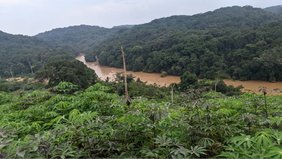The Killing of a Gorilla and the Destruction of Habitats in the Maiko National Park
Categories: Journal no. 69, Threats, People & Gorillas, Democratic Republic of the Congo, Maiko, Grauer's Gorilla
The Grauer's gorilla is facing a major crisis. Several factors are threatening its habitat: agricultural and pastoral expansion, subsistence hunting, bushmeat exploitation and the illegal trade in exotic animals. In addition, intensive mining and a decade of civil war, combined with socio-economic depression, are seriously affecting forest resources and wildlife in the Democratic Republic of the Congo (DRC).
Since 1996, the entire range of the Grauer's gorilla has been affected by conflict. This has led to a total collapse of government control, including wildlife protection activities. Large populations of this gorilla subspecies as well as chimpanzees have not been monitored for many years and, as a result, the current status of the Grauer's gorilla has been poorly documented since the surveys conducted by the New York Zoological Society (now the Wildlife Conservation Society, WCS), with contributions from Berggorilla & Regenwald Direkthilfe, between 1989 and 1992 (Hart & Sikubwabo 1994) and by the WCS between 1993 and 1995 (Hall et al. 1998). The conservation challenges are likely to increase as the destabilisation of the DRC continues to grow.
The threat to Grauer's gorillas is not new. More than 120 armed groups are thought to be active in eastern DRC, some of them using the Maiko forests to extract resources for their survival and operations, as cover for hunting and military training. Conflict over resources and territory has led local militias to invade and exploit the region, resulting in deforestation, extraction of raw materials, poaching and illegal farming.
On Sunday 20 October 2024, the body of a Grauer's gorilla killed in the Maiko National Park was brought back to the village of Burondo by poachers to be eaten. The lack of an established local authority and the absence of ICCN (Institut Congolais pour la Conservation de la Nature) officers made it possible for this poaching to go unpunished. Burondo is a mining patch in the Maiko National Park, a 3-hour walk from the former Loya patrol post, 1 hour from the village of Tshopo and 2 days from the former Mandaye patrol post. The tragic death of this gorilla was caused by humans (poachers), and is a blow to all of us fighting to protect this endangered species. Local poachers illegally set traps in the park to catch antelopes and other animals for food, but unsuspecting gorillas, particularly baby gorillas and young gorillas, sometimes fall into these traps.
A natural habitat is being destroyed
While poaching is one of the major causes of the gorillas' disappearance, the destruction of their habitat is another major factor. Living in forests, gorillas have suffered from the consequences of deforestation, which has long since decimated their natural habitat. As a result, only 10 % of their territory is expected to be intact by 2030! Gold mining using dredging machines, and artisanal mining, is destroying the Maiko's main primary forests day by day. As a result, the great apes are seeing their habitats and food resources rapidly diminished for the benefit of the large mining companies, which are fragmenting and destroying their ecosystems. We have a duty to protect all animal life, because it is our responsibility to preserve nature and all the creatures living there.
More than three quarters of the Maiko National Park are unprotected, including almost all of the Central Sector. The eco-guards of the Central Sector are based in the village of Adusa, located 70 km from the park boundary, too far away to effectively protect the park. They are just there to control the bush meat trade. Hence, there are no patrols in this part of the park.
In order to mitigate this destruction, NGOs or Local Community Forest Concessionaires (CFCL) should sensitise the population and all other stakeholders involved in conservation about their heritage and show them that progressive losses of habitats or fauna can lead to the total loss of ecosystems.
As a result of the activities destroying forest ecosystems, especially in the eastern part of the Maiko Central and Southern Sectors, elephants tend to abandon their main home ranges (Maiko National Park) and head for the villages where they destroy crops and create conflicts with the local population.
The elephants have just spent more than 6 months around the villages of Makutaniyo (a village located at the confluence of the Lubero and Lindi rivers), Mabombi and Vumilia. It is estimated that 10 ha of cassava fields, 12 ha of banana plantations and 2 ha of maize fields have been destroyed by elephants in the last 6 months. The local people do not know which way to turn. If the government does not find a solution to this problem, a spirit of vengeance could be stirred up by the destruction. The remoteness of these places from the main roads and the presence of dozens of armed groups make it difficult for ICCN and government agents to stay in these places.
Papy Kabaya Mahamudi and Claude Sikubwabo Kiyengo
References
Hall, J. S. et al (1998): Distribution, abundance and conservation status of Grauer's gorilla. Oryx 32, 122-130
Hart, J. A. & Sikubwabo, C. (1994): Exploration of the Maiko National park of Zaire 1989-1992. History, environment and the distribution status of mammals. WCS
Plumptre, A. J. et al. (2016): Catastrophic Decline of World's Largest Primate: 80% Loss of Grauer's Gorilla (Gorilla beringei graueri) Population Justifies Critically Endangered Status. PLoS ONE 11 (10): e0162697
Plumptre, A. J. et al. (2021): Changes in Grauer's gorilla (Gorilla beringei graueri) and other primate populations in the Kahuzi-Biega National Park and Oku Community Reserve, the heart of Grauer's gorilla global range. American Journal of Primatology 83 (7), e23288

